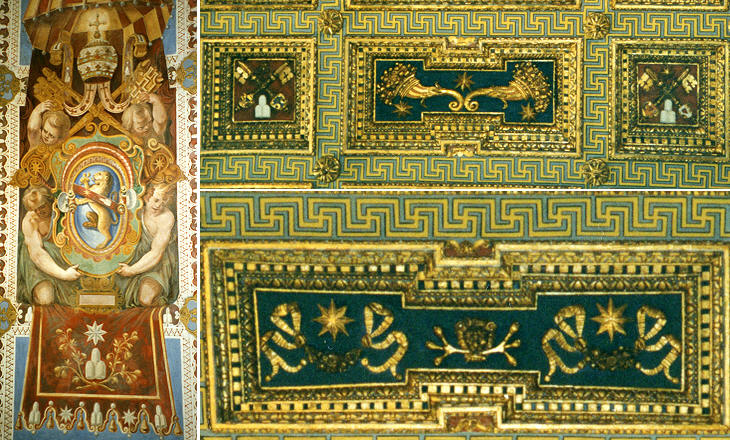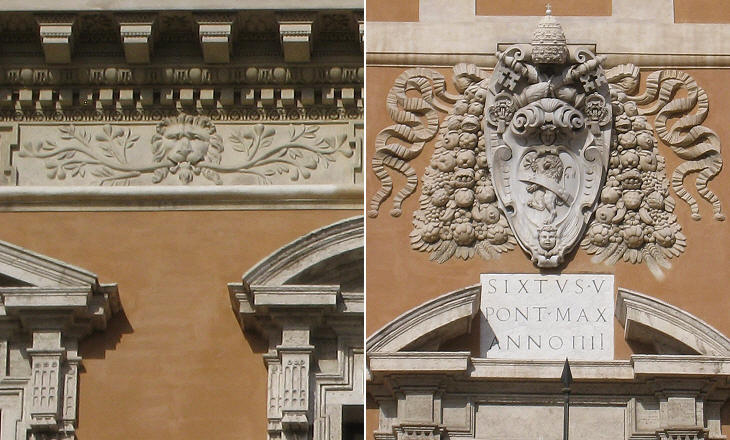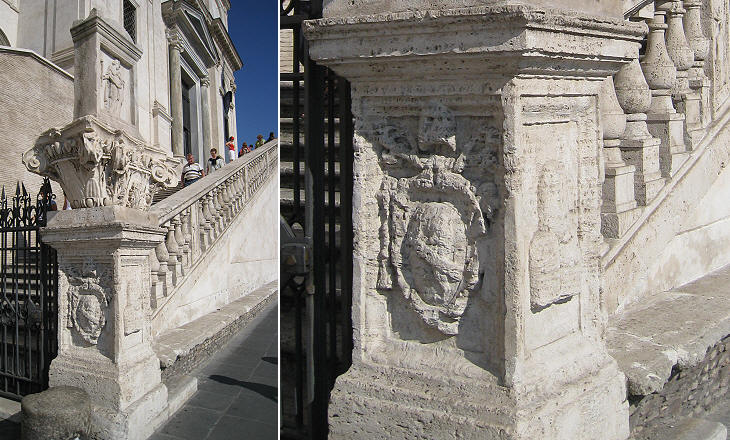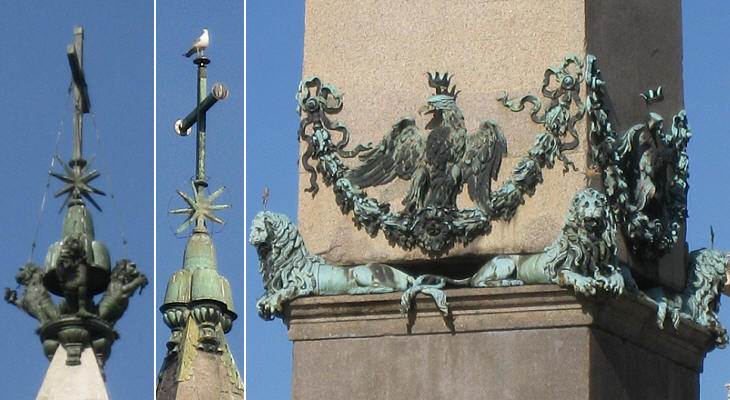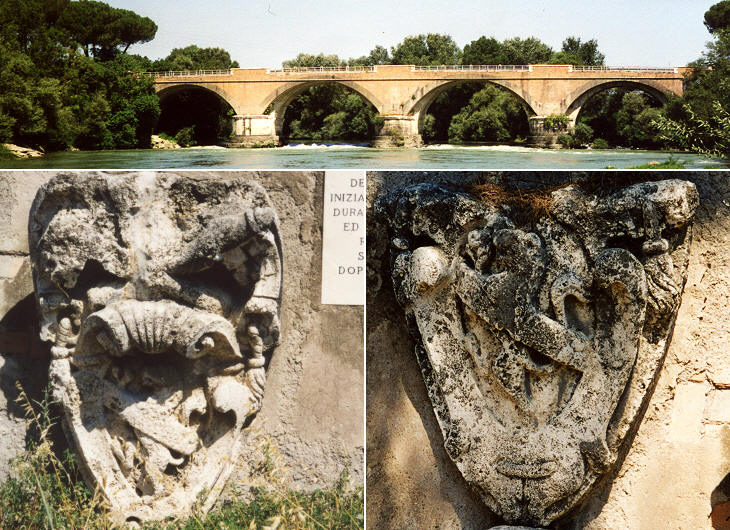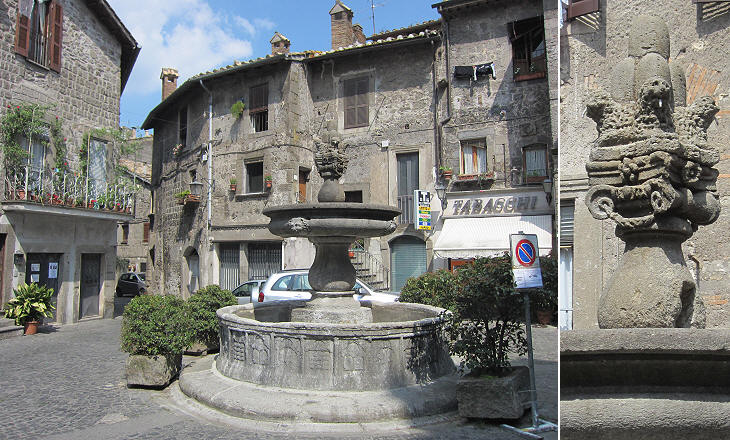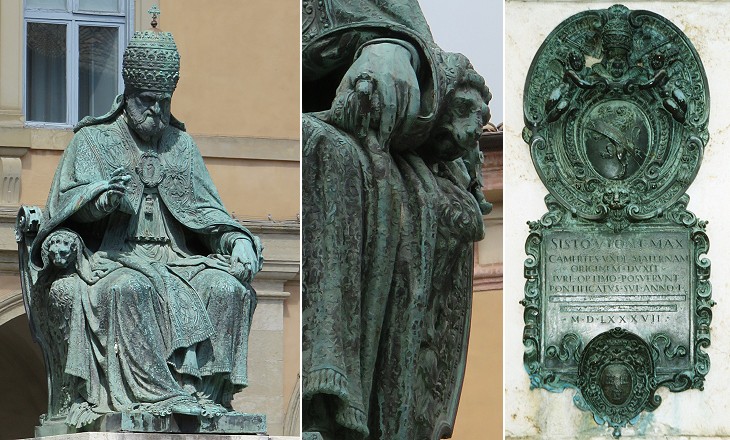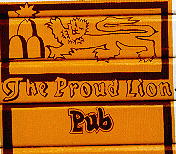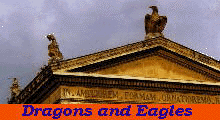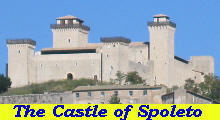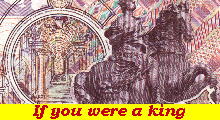  What's New! Detailed Sitemap All images © by Roberto Piperno, owner of the domain. Write to romapip@quipo.it. Text edited by Rosamie Moore. |
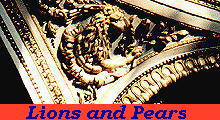 LIONS AND PEARS LIONS AND PEARS
The Iron Pope Pope Sixtus V (Felice Peretti) was 64 when he became Pope in 1585. Because of his age (and perhaps as a legend says because of his apparent poor health) he was expected to have little impact on the government of Rome. On the contrary, Sixtus V in five years left a great mark of his strong will and of his self-esteem. Born into a poor family in the little village of Montalto (he will be also known as Cardinal Montalto) in the remote Marca d'Ascoli he adopted a complex coat of arms with four symbols: a rampant lion holding pears (as a reminder of his family name Peretti) and three mountains topped by a star. These symbols not only appear in his formal coat of arms, but are used as a decoration of buildings and churches.
The picture above shows the ceiling decoration of two rooms in the Palace of the Lateran (map4 40/H6) which was reconstructed by Sixtus V, who left his mark also on the exterior of the palace, not only in the formal coat of arms above the entrance, but also in the decoration with this fascinating and somewhat incredible lion with branches of pears in his mouth. One of the reasons for this somewhat hidden reminder of himself can be traced to his mistrust of mankind including the popes who will follow.
In fact sometimes a pope would replace a coat of arms of a predecessor with his own, just for some minor works or repairs: so the decoration had a better chance of survival. Trinit� dei Monti SS. Trinit� dei Monti is on the line which connects Piazza del Popolo to Santa Maria Maggiore. This road was called Strada Felice after the Pope's first name, today the section from Trinit� dei Monti to Piazza Barberini is called Via Sistina after his name as a pope. It is one of six rettifili (straight streets) by which the Pope designed the future expansion of Rome. Here in Trinit� dei Monti (map2 11/E2) only the pillar of the steps leading to the church reminds us of the Pope. The lion and the pears are barely recognizable, but the three mountains are clearly visible.
Obelisks There are more obelisks in Rome than anywhere else. Brought to Rome by the Emperors and put in the circuses and the stadiums, they had almost all fallen when Sixtus V became a pope. He and his architect Domenico Fontana restored them and used them as the focal point for the rettifili. On top of the obelisk the pope wanted a reference to his coat of arms. The picture below shows the top of the obelisks in Piazza S. Giovanni in Laterano and Piazza del Popolo. The obelisk in Piazza S. Pietro comes from the nearby Circus of Nero and its erection was quite a technical achievement. The obelisk is seated upon four lions of Sixtus V. On their heads a star, another symbol of the pope. Later on Pope Innocent XIII added his chequered eagle. See a section on a 1588 Guide to Rome.
Ponte Felice Ponte Sisto was built by Sixtus IV, but also Sixtus V wanted to link his name to a new bridge on the Tiber. He did so near Magliano Sabina on the Via Flaminia and he named it after himself (Felice). Ponte Felice was built on dry ground and then the river-bed was modified. The bridge was very much damaged during World War II and it was then rebuilt and enlarged making use of the original foundations. Some of the coats of arms were recovered and are now shown on a wall at the beginning of the bridge.
A little Fountain in Bagnaia
Bagnaia a few miles from Viterbo is a small town, with a Villa (Villa Lante) which has an impressive Italian garden. In the main square this little fountain bears the signs of the pope (it was built by his nephew Cardinal Montalto, governor of Viterbo). The three mountains are also noticeable around the base of the fountain. A similar fountain can be seen in Piazza d'Aracoeli in Rome. In his Homeland In the Marche, especially in the southern part, Sixtus V is still regarded as a national hero. Towns and villages are proud of being the birthplace of the pope, or of his parents and other relatives and there are several references to him. Camerino, Fermo and Loreto erected in his honour bronze statues showing him sitting on the papal throne with lions coming out of his robe. Below the statue in Camerino where the pope's mother was born.
In Borgo
In the narrow streets of Borgo I came across this tribute to Sixtus V! It can be explained by the fact that Sixtus V made of Borgo (the area between St. Peter's and the Tiber) a formal district of Rome in 1586. The coat of arms of Borgo is a copy of Sixtus' coat of arms (only the pears are missing). Note: the background is taken from the entrance of Palazzo della Cancelleria and the icon at the top of this page shows a detail of the Sistine Chapel in Santa Maria Maggiore. Note: the three mountains topped by a star can be confused with: a) the coat of arms of Alexander VII 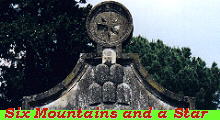 b) the coat of arms of Clement XI 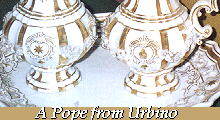 . .
 SEE THESE OTHER EXHIBITIONS (for a full list see my Detailed Index) |
